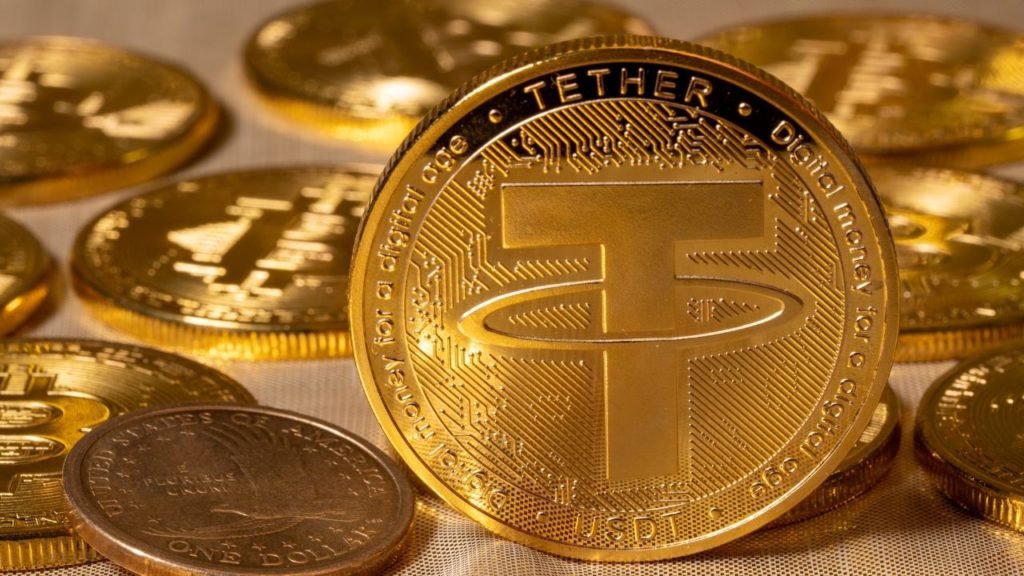Stablecoin Innovations With Algorithmic Stablecoins and Their Risks
In the ever-evolving world of cryptocurrencies, stablecoins have emerged as a crucial component. These digital assets are designed to maintain a stable value, usually by pegging themselves to a reserve asset such as a traditional fiat currency. While the most common type of stablecoins are those backed by real-world assets, like USDC or USDT, there is another breed of stablecoins known as algorithmic stablecoins. This article delves into the concept of algorithmic stablecoins, their innovations, and the associated risks.
Understanding Algorithmic Stablecoins

Algorithmic stablecoins, also referred to as seigniorage-style or elastic supply stablecoins, are a unique category of cryptocurrencies that do not rely on collateralized reserves. Instead, their supply is algorithmically adjusted to maintain price stability. These stablecoins are typically decentralized and governed by smart contracts, which control the issuance and burning of tokens based on market demand.
One of the first algorithmic stablecoins to gain widespread attention was Ampleforth (AMPL), which introduced a novel concept: the supply of AMPL tokens expands or contracts daily, depending on the token’s price relative to a predefined target price. If the price is above the target, more tokens are minted, and if it’s below the target, tokens are burned. The goal is to create a self-regulating system that theoretically maintains a stable value.
Innovations in Algorithmic Stablecoins
Algorithmic stablecoins have seen numerous innovations and experiments over the years. These innovations are aimed at improving the stability and functionality of these digital assets. Some notable developments include:
-
- Multi-Token Models:Algorithmic stablecoins like Terra (LUNA) have introduced multi-token models to enhance stability. Terra operates with two primary tokens: Terra (UST) and Anchor (ANC). UST is the stablecoin, while ANC serves as a governance token and represents stability fees. This dual-token system enables more control over the stability of UST. When UST is trading above its peg, Anchor’s yield is directed towards UST to encourage stability. Conversely, when UST is below its peg, Anchor’s yield is distributed to ANC stakers. This mechanism encourages users to participate actively in the system’s stability.
- Oracles and Price Feeds:Reliable price data is crucial for algorithmic stablecoins to adjust their supply and maintain their peg. Chainlink, an oracle network, has played a significant role in this regard. It provides secure and decentralized price feeds for a wide range of assets. Algorithmic stablecoins can use these price feeds to determine whether the coin’s price is above or below the target and, accordingly, adjust the token supply. The integration of oracles enhances the reliability of these stablecoins by ensuring they have access to accurate real-time market data.
- Governance Mechanisms:Many algorithmic stablecoins have embraced decentralized governance systems, allowing token holders to participate in decision-making processes. For instance, MakerDAO, the pioneer of decentralized stablecoins with its DAI token, uses the MKR token for governance. MKR holders can vote on various proposals and changes within the ecosystem. This democratic approach not only empowers the community but also helps make critical decisions related to collateral types, stability fees, and other parameters.
- Dynamic Collateralization:Some algorithmic stablecoins have introduced innovative collateralization models. OlympusDAO, for example, uses a dynamic collateralization approach to stabilize OHM, its algorithmic stablecoin. The system continuously adjusts the collateral ratio based on market conditions and supply dynamics. This means that the amount of collateral required for each OHM is not static but varies according to the market’s demands and the protocol’s health.
- Liquidity Pools and Staking:Algorithmic stablecoins have often introduced liquidity pools and staking mechanisms to enhance their stability. Users can participate by providing liquidity to these pools, which can yield returns based on the protocol’s needs. Staking, as seen in projects like Frax (FXS), allows users to earn rewards while helping to stabilize the stablecoin.
- Elastic Supply Algorithms:The core innovation of algorithmic stablecoins is the elastic supply mechanism. These algorithms adjust the token’s supply daily or even more frequently based on the token’s price relative to a target price. When the token’s price is above the target, the algorithm increases supply, and when it’s below, it decreases supply. This dynamic adjustment is what theoretically maintains the coin’s stability without relying on collateral.
- Cross-Chain Integration:Some algorithmic stablecoins are not confined to a single blockchain. They utilize cross-chain compatibility to reach a broader audience. For example, the integration of algorithmic stablecoins like Terra (LUNA) with multiple blockchains allows users to access these stable assets on different ecosystems, promoting interoperability.
Also, read – The Real Risks Of Stablecoins That Investors Must Know
Risks Associated with Algorithmic Stablecoins
While algorithmic stablecoins present intriguing innovations, they also come with a set of risks:
- Algorithmic stablecoins are a fascinating development in the world of cryptocurrencies, aiming to maintain price stability by employing algorithms and smart contracts. However, like any innovative financial technology, they carry a set of risks that investors and users should be aware of. Here’s a more detailed exploration of the risks associated with algorithmic stablecoins:
- Price Volatility: Algorithmic stablecoins are designed to maintain a stable value, but they are not immune to price volatility. In fact, they can experience sharp price fluctuations, especially during their early stages of adoption. Factors like low liquidity and market sentiment can lead to sudden and significant price swings.
- Smart Contract Risks: Algorithmic stablecoins heavily rely on complex smart contracts. Vulnerabilities or bugs in these contracts can lead to hacks, exploits, and fund losses. The immutability of blockchain makes it challenging to rectify such issues once they occur.
- Lack of Collateral: Traditional stablecoins like Tether are backed by real-world assets like fiat currency. In contrast, algorithmic stablecoins often lack collateral, relying on mechanisms like seigniorage to maintain stability. If the underlying algorithm fails to work as intended, the stablecoin may lose value.
- Over-Issuance Risk: Many algorithmic stablecoins automatically issue new tokens when their value is above the peg and burn tokens when below the peg. However, if the system over-issues tokens, it can lead to inflation and a permanent loss of value.
- Governance and Centralization: Some algorithmic stablecoins involve governance tokens and voting mechanisms to make protocol changes. This can lead to centralization if a few entities or large token holders have significant influence, potentially compromising the stability and decentralization of the stablecoin.
- Market Sentiment: Algorithmic stablecoins are influenced by market sentiment and trader behavior. A sudden lack of confidence in the system or widespread panic selling can disrupt the stablecoin’s stability mechanisms.
- Liquidity Risks: Low liquidity can result in slippage and make it difficult to buy or sell algorithmic stablecoins without causing significant price movements.
- Regulatory Risks: Regulatory authorities are still evolving their stance on algorithmic stablecoins. Changes in regulations or enforcement actions can pose risks to users and the stablecoin’s operation.
- Black Swan Events: Algorithmic stablecoins may not be prepared for extreme, unforeseen events that can impact the entire crypto market. Such “black swan” events can trigger substantial instability.
- Complexity: Algorithmic stablecoins are often intricate systems that may be challenging for the average user to understand. This complexity can result in unintended actions and mistakes that lead to financial losses.
In conclusion, while algorithmic stablecoins offer exciting opportunities, they are not without risks. Potential users and investors should conduct thorough research, understand the underlying mechanisms, and carefully evaluate the risk factors associated with these innovative financial instruments. Due diligence and caution are essential when engaging with algorithmic stablecoins to mitigate these risks.
https://twitter.com/i/status/1718194297751646303
FAQ’s about Stablecoin
- What is the most popular algorithmic stablecoin?The most popular algorithmic stablecoin is Ampleforth (AMPL). AMPL was one of the earliest algorithmic stablecoins to gain widespread attention and is often considered a pioneer in this category. It introduced a unique elastic supply mechanism where the supply of tokens is adjusted daily based on the token’s price relative to a target price, making it a noteworthy player in the algorithmic stablecoin space.
- What is an example of an algorithmic stablecoin?One prominent example of an algorithmic stablecoin is Terra (LUNA). Terra’s ecosystem includes Terra (UST), which is a stablecoin, and it operates with a dual-token model. UST’s supply is algorithmically adjusted to maintain its peg to the US dollar. Terra’s algorithmic design and integration with multiple blockchains make it a notable example of an algorithmic stablecoin.
- What is the purpose of algorithmic stablecoins?The primary purpose of algorithmic stablecoins is to provide a digital asset with a stable value that does not rely on traditional collateral like fiat currency or other assets. They aim to achieve price stability by automatically adjusting the supply of tokens based on market demand. This makes them useful for various applications, including serving as a stable medium of exchange, a unit of account, and a store of value within the volatile cryptocurrency ecosystem.
- What are the advantages of algorithmic stablecoins?Algorithmic stablecoins offer several advantages:
- Decentralization: Algorithmic stablecoins often operate on blockchain networks and smart contracts, making them decentralized and resistant to central authority control.
- Reduced Reliance on Collateral: Unlike traditional stablecoins that require collateral, algorithmic stablecoins adjust their supply dynamically, reducing the need for large reserves.
- Global Accessibility: Algorithmic stablecoins can be accessed and used by anyone with an internet connection, providing financial services to individuals globally.
- Innovation: These stablecoins introduce innovative mechanisms, such as multi-token models, dynamic collateralization, and decentralized governance, offering unique features and use cases.
- Interoperability: Some algorithmic stablecoins like Terra are cross-chain compatible, allowing users to access stable assets across various blockchain ecosystems.
- Participation: Users can actively participate in the governance and stability of these stablecoins, fostering a sense of community and shared decision-making.
Despite these advantages, it’s important to note that algorithmic stablecoins also come with risks and challenges, including price volatility, complexity, and regulatory uncertainties, as discussed in previous responses.
Stay informed with daily updates from Blockchain Magazine on Google News. Click here to follow us and mark as favorite: [Blockchain Magazine on Google News].
Get Blockchain Insights In Inbox
Stay ahead of the curve with expert analysis and market updates.
latest from tech
Disclaimer: Any post shared by a third-party agency are sponsored and Blockchain Magazine has no views on any such posts. The views and opinions expressed in this post are those of the clients and do not necessarily reflect the official policy or position of Blockchain Magazine. The information provided in this post is for informational purposes only and should not be considered as financial, investment, or professional advice. Blockchain Magazine does not endorse or promote any specific products, services, or companies mentioned in this posts. Readers are encouraged to conduct their own research and consult with a qualified professional before making any financial decisions. The featured image used is just a creative depiction of the title and it does not intend to hurt sentiments of any person or institution. If it hurts anyone sentiments, please do not hesitate to reach out to Blockchain Magazine.

 Bitcoin
Bitcoin  Ethereum
Ethereum  XRP
XRP  Tether
Tether  Solana
Solana  USDC
USDC  Dogecoin
Dogecoin  Cardano
Cardano  Lido Staked Ether
Lido Staked Ether  TRON
TRON  Wrapped Bitcoin
Wrapped Bitcoin  Chainlink
Chainlink  Wrapped stETH
Wrapped stETH  Sui
Sui  Avalanche
Avalanche  Stellar
Stellar  Hedera
Hedera  Toncoin
Toncoin  Shiba Inu
Shiba Inu  LEO Token
LEO Token  Hyperliquid
Hyperliquid  Bitget Token
Bitget Token  Litecoin
Litecoin  WETH
WETH  USDS
USDS  Polkadot
Polkadot  Bitcoin Cash
Bitcoin Cash  Ethena USDe
Ethena USDe  MANTRA
MANTRA  Wrapped eETH
Wrapped eETH  Uniswap
Uniswap  Pepe
Pepe  Ondo
Ondo  Monero
Monero  Aave
Aave  WhiteBIT Coin
WhiteBIT Coin  NEAR Protocol
NEAR Protocol  Mantle
Mantle  Official Trump
Official Trump  Aptos
Aptos  Dai
Dai  Internet Computer
Internet Computer  Ethereum Classic
Ethereum Classic  Bittensor
Bittensor  Cronos
Cronos  OKB
OKB  POL (ex-MATIC)
POL (ex-MATIC)  Gate
Gate 






